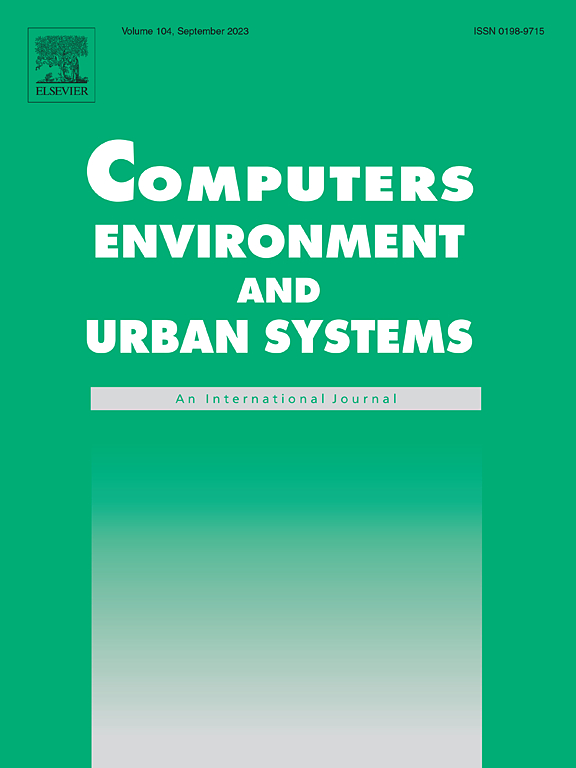行人量模型的比较分析:基于agent的模型、机器学习方法和多元回归分析
IF 8.3
1区 地球科学
Q1 ENVIRONMENTAL STUDIES
Computers Environment and Urban Systems
Pub Date : 2024-12-13
DOI:10.1016/j.compenvurbsys.2024.102238
引用次数: 0
摘要
行人流量分布可以为可步行性规划提供信息,并提高对影响行人活动因素的理解。然而,详细的数据很少可用,因此通常依赖于空间语法框架的行人量模型经常用于预测行人量。本研究比较了以色列特拉维夫-雅福三个建模家族的性能和主导变量——多元回归分析、机器学习模型和基于代理的模型。利用247个流量观测数据,对每个家庭的最优模型进行拟合,并对3个不同城市增长和形态特征的不同区域以及整个城市进行验证。结果表明,基于集成的机器学习模型最适合全市范围的预测,而基于代理的模型在社区的局部规模上具有优势,尤其是在没有以自组织过程发展的社区。回归分析在所有领域都不足,即使使用主成分分析来减少多重共线性和过拟合。这些差异归因于认知行为和结构因素对行人流量的相对影响:基于主体的模型在单个区域优于统计模型,在单个区域中,使用一小组认知行为参数更准确地捕获行为。统计模型在全市范围内占主导地位,其中结构变量可以预测总体模式。在评估规划好的城市环境中的行人分布时,这一点至关重要。总体而言,我们的研究结果表明,逐步回归不足以用于行人数量建模,基于智能体的模型可以更好地捕获自变量之间的复杂相互作用,机器学习模型在城市范围内的行人数量建模中具有强大的潜力。本文章由计算机程序翻译,如有差异,请以英文原文为准。
Comparative analysis of pedestrian volume models: Agent-based models, machine learning methods and multiple regression analysis
Pedestrian flow distributions can inform planning for walkability and improve understanding of factors that influence pedestrian activity. However, detailed data is rarely available so pedestrian volume models, commonly relying on the Space Syntax framework, are often utilized to predict pedestrian volumes. This study compares the performance and dominant variables of three modelling families – multiple regression analyses, machine learning models, and agent-based models – in Tel Aviv-Yafo, Israel. Using 247 flow observations, optimal models from each family were fitted and validated for 3 separate areas that differ in their urban growth and morphological characteristics, as well for the whole city. Results showed that ensemble-based machine learning models were best for city-wide predictions while agent-based models had an advantage at the local scale of neighborhoods – especially in neighborhoods that did not develop in a self-organized process. Regression analyses fell short for all areas, even when using principal component analysis to reduce multicollinearity and overfitting. These differences are attributed to the relative influence of cognitive-behavioral and structural factors on pedestrian flows: agent-based models outperform statistical models in individual areas, where behavior is captured more accurately using a small set of cognitive-behavioral parameters. Statistical models are dominant in the city-wide context, where structural variables can predict aggregate patterns. This is crucially important when evaluating the distribution of pedestrians in a planned urban environment. Overall, our results indicate that stepwise regression are not sufficient for pedestrian volume modelling, that agent-based models better capture complex interactions between independent variables, and that machine learning models have a strong potential for city-wide pedestrian volume modelling.
求助全文
通过发布文献求助,成功后即可免费获取论文全文。
去求助
来源期刊

Computers Environment and Urban Systems
Multiple-
CiteScore
13.30
自引率
7.40%
发文量
111
审稿时长
32 days
期刊介绍:
Computers, Environment and Urban Systemsis an interdisciplinary journal publishing cutting-edge and innovative computer-based research on environmental and urban systems, that privileges the geospatial perspective. The journal welcomes original high quality scholarship of a theoretical, applied or technological nature, and provides a stimulating presentation of perspectives, research developments, overviews of important new technologies and uses of major computational, information-based, and visualization innovations. Applied and theoretical contributions demonstrate the scope of computer-based analysis fostering a better understanding of environmental and urban systems, their spatial scope and their dynamics.
 求助内容:
求助内容: 应助结果提醒方式:
应助结果提醒方式:


